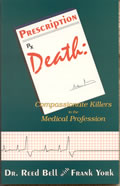Other
Howenstine Articles:
Use of CoQ10
to Treat Malignancies
Why You Should Avoid Taking Vaccines
70% OF AMERICANS LACK ADEQUATE VITAMIN D
By Dr. James
Howenstine, MD.
January 15, 2004
NewsWithViews.com
Lack of Vitamin D has always been found among the elderly and the housebound. Deficiency of Vitamin D is related to higher rates of breast, ovary, colon, and prostate cancer; increased incidence of multiple sclerosis, progression of osteoarthritis, impairment of the immune response, high blood pressure, mood disorders including serious depression, Type 1 diabetes and tuberculosis. Lack of Vitamin D appears to be a prime factor in the rising incidence of depression along with a lack of omega 3 fatty acids. Patients with Parkinson's disease, multiple sclerosis, congestive heart failure, and Alzheimer's disease have all been found to have significant deficits of Vitamin D.
In an important study from the March 19, 1998 New England Journal of Medicine, 290 patients admitted to Massachusetts General Hospital were studied for evidence of Vitamin D deficiency. 57 % of these patients were found to be Vitamin D deficient and in 22% the deficiency was severe. In a subgroup of 77 healthy patients with an average age of 44 years, 42% were Vitamin D deficient and in 11 % the lack was severe.
A surprising and disconcerting finding in this study was that 46 % of those regularly taking vitamin supplements were found to be lacking adequate Vitamin D in their blood. Research by Dr. Reinhold Vieth appears to unravel this puzzle. Dr. Vieth and his colleagues at the University of Toronto have learned that any amount of vitamin D below 800[1] IU daily was unable to prevent Vitamin D deficiency from occurring. He thinks that the proper dosage of vitamin D may be 1200 IU. or more.. Very few vitamin preparations in the U.S. contain this quantity of Vitamin D so you will need to supplement your intake with additional Vitamin D until you find an adequate vitamin preparation...
Osteoporosis is now being diagnosed in women in their 40's. These patients exhibit intense bone pain, muscle weakness, and even difficulty in walking. Some women with fibromyalgia who have similar symptoms have been discovered to have lower than normal bone density, which is very suspicious of osteoporosis. 20 % of the patients in rheumatologists offices are suffering from fibromyalgia, which is a very common and very disabling problem for many women. All persons suspected of fibromyalgia should have Vitamin D blood levels checked. Therapy is easy with Vitamin D, calcium and magnesium..
Dr. Plotnikoff of the Univ. of Minnesota Medical School measured 25 (OH) D [calcidiol] blood levels in 150 patients in a chronic pain clinic. He discovered that 100 % of Black, Hispanic, East African and American Indians were Vitamin D deficient[2] . 93 % of all patients were Vitamin D deficient. Young women in their childbearing years were found to be at the greatest risk for not being diagnosed. Many of these patients had been having pain for years without ever having Vitamin D levels checked. This suggests that chronic musculoskeletal pain is often caused by undiagnosed vitamin D deficiency. Pigmented individuals appear to be at greater risk because they do not absorb Vitamin D nearly as well as white persons through their skin..Almost certainly the widespread use of sunglasses and sun screens is contributing to this problem.
A serious problem in the elderly is falls. These falls often cause hip fractures which frequently prevent the patient from returning to independent living. Specific receptors for Vitamin D have been identified in muscle tissue. Vitamin D deficiency results in muscle weakness and impaired balance which contributes to falls in the elderly. A 49 % reduction in falls[3] was found in a geriatric facility containing 120 elderly women when 1200 mg of Vitamin D was added to 1200 mg. of calcium given to all women. Muscle testing disclosed significant improvement in the group getting 1200 units of Vitamin D when compared to those getting only calcium. Magnesium should always be provided in the therapy of osteoporosis as failure to do so can make the bone structure even more fragile..
Ultraviolet light initiates the conversion of a Vitamin D precursor in the skin (precholesterol) to cholecalciferol a substance that is changed in the liver into calcidiol. After passage through the kidney the calcidiol is converted into calcitriol. Calcitriol regulates calcium metabolism in the body and has important beneficial effects on human development, diabetes, hypertension, heart disease, autoimmune illnesses, 13 different cancers and depression.
A young white male makes 20,000 units of Vitamin D within minutes of whole body exposure to the summer sun (before redness of skin appears). This is five times the amount of Vitamin D considered capable of initiating toxic reactions[4] by the Institute of Medicine proving that these guidelines are set far too low..Dark skinned individuals need 5 to 10 times longer in the sun to produce an equivalent amount of vitamin D depending on the extent of their pigmentation.
Blood levels of calcidiol [25(OH)D] below 35 ng/ml are found in 70 % of U.S. citizens. Normal values are considered to be between 35 and 50 ng/ml. Life guards and persons living near the equator have values near 50 ng/ml. Toxicity from excess Vitamin D during sun exposure does not occur because ultraviolet light degrades Vitamin D after 20,000 units have been produced thus leading to a steady state and no toxicity..
Avoid sunburn which can injure the skin. Sunscreens with a protection factor of 8 block 95 % of vitamin D production. With equal sun exposure, an 80 year old produces only 50 % of the Vitamin D made by an 8 year old.
Living in cities, working in factories, screening out ultraviolet light with glass windows, wearing more clothing than when farming, using sun screens and dark glasses all contribute to the deficient Vitamin D levels found today. One of the routes for ultraviolet light to be received by the body is through the eye as well as the skin. Ultraviolet deprivation may be responsible for the dramatic increase in cancer seen in certain parts of Africa. Albert Schweitzer noted that when he arrived in Africa the natives did not wear sunglasses and that he rarely saw cancer. Later natives could be seen pulling their canoes down the river wearing sunglasses and not much else. The failure to receive ultraviolet through their eyes because of sunglasses made them vulnerable to ultraviolet light deficiency as black skinned persons do not absorb much ultraviolet through their skin.
John Ott has done monumental work in the field of photobiology. This work has proven that the full spectrum of visible light (and some of the invisible) is absolutely essential for good health. Ott has shown that light is just as important a photosynthesizing mechanism in animals as it is in plants; only the mechanism is different.
In the June 1990 issue of The Reader's Digest Dr. David Ruben wrote an article about ultraviolet light blaming 600,000 cases of skin cancer annually on this form of light. He goes on to say that exposing their bodies to the sunlight is one of the riskiest things Americans can do.
Blaming the ultraviolet light from the sun for skin cancer appears to be incorrect. The skin cancer problem is not caused by ultraviolet light. In Australia skin cancer is two times more common in persons eating margarine than persons eating butter. Butter contains an ingredient that appears to prevent the development of skin cancer. The synthetic fats found in margarine, salad oils and cooking oils are very hard for the body to dispose of. This leads to massive amounts of free radicals, immune injury, high cholesterol, cancer, obesity and arteriosclerosis in persons consuming these abnormal fats. The skin cancer seen in Australia occurs more commonly in office workers than those employed outdoors such as lifeguards.
John Ott states that we need more ultraviolet light than we obtain from artificial light through windows. Ultraviolet light of the short wave length, germicidal ultraviolet, is mostly filtered out by the earth's atmosphere. This fear of getting too much ultraviolet light is creating a deficiency of an essential life supporting energy.
Ott further relates that there is probably a relationship between chronic diseases and lack of sunlight. "My studies have shown that light is a nutrient, similar to all the other nutrients we take in through food and that we need the full spectrum range of natural sunlight". If human skin is not exposed to solar radiation (direct or scattered) for long periods of time, disturbances will occur in the physiological equilibrium of the human system. The result will be disorders of the nervous system, vitamin D deficiency, weakening of the body's defenses, depression and an aggravation of chronic diseases".
He calls this state malillumination (lack of necessary sunlight). This develops when wavelengths are missing in various types of artificial light or are filtered from natural light passing through window glass, windshields, tinted eyeglasses, smog, and sun tan lotions. The minerals and chemicals in the individual cells of our bodies that would normally be nourished by the missing wavelengths remain in the equivalent of darkness.
In other words energy cannot be extracted from food materials if the proper wavelengths of light are not available to help break them down chemically.
Dr. Ott has called the attention of the medical profession to the dangers of using tinted eyeglasses. He has perfected gray-tinted lenses that will allow the passage of all wavelengths of light. The majority of sunglasses available today do not permit full transmission of light and are clearly detrimental to the health of the wearer.
Many women are unable to become pregnant because of the use of tinted sunglasses in Ott's opinion.. He advised 6 infertile women to throw away their sunglasses and they all became pregnant. Estrogen, an essential hormone for conception, has a sharp peak in absorption of ultraviolet light at 280 manometers. This frequency of light is usually filtered out by sunglasses and this causes failure of proper activation of estrogen with inability to conceive.
Dr. Ott did another study with cancer patients, which showed clear prolongation of life. He advised 15 cancer patients to spend as much time as possible in sunlight and to avoid artificial light sources including television. 14 of the 15 showed no progression of their tumors and several actually showed improvement. The one person who failed to improve had misunderstood the directions and continued to wear sunglasses.
Seasonal Affective Disorders (SAD)
John Ott's work Seasonal Affective Disorders has become recognized as a common well accepted syndrome which occurs in fall and winter in northern countries due to light deficiency. Patients with this disorder develop fatigue; sadness, excessive sleeping, overeating, carbohydrate craving and weight gain during the short days of winter. These changes can be reversed by extending the daily light period using 5 to 6 hours of bright, 2500 lux, full spectrum light either in the morning and evening hours or evening hours alone. The anti-depressive effects of this treatment take two to four days to appear, and relapse occurs in the same number of days if treatment is stopped. These behavioral improvements are believed to be caused by decreased secretion of melatonin from the pineal gland in a light enhanced environment. SAD affects only 1.4 % of persons living in Florida, whereas the in New Hampshire, the incidence approaches 10 %. Alaska also manifests a 10 % incidence of SAD in the winter months.
Dr. Niels Finsen, a Danish researcher, won the Nobel Prize in 1903 for his discovery that the tuberculosis like skin disease called lupus vulgaris could be cured in 98 % of cases by ultraviolet light. To learn whether this success was due to a direct effect of the ultraviolet light on the affected skin or was simply due to benefits from ultraviolet on the immune system he treated some patients by exposing only unaffected normal skin to ultraviolet light. These patients recovered equally well as those whose skin lesions were directly treated proving that the immune system was being helped by the ultraviolet rays. Recent research has revealed that Vitamin D has profound activity as an anti-oxidant as well as it's mineral absorptive and other benefits.
A physician named Auguste Rollier established a series of chalets in the Swiss Alps and other locations to treat individuals with tuberculosis in the early 1900s. All patients were exposed to the sun for 3 hours daily in the summer and 4 hours daily in the winter without permitting sunburn. This exposure to sunlight was able to convert sick deformed children with spinal tuberculosis into healthy energetic children with straight backs over a period of 18 months. This therapy also worked for abscesses, bone infections, rickets, anemias and non healing wounds as well, probably by the immune stimulation from Vitamin D.
It is hard to imagine persons living in a hot sun filled desert not getting enough Vitamin D but a recent research paper from Saudi Arabia establishes that this occurs. 300 patients with chronic back pain and low levels of [25(OH)D] were treated with 5,000 to 10,000 units of cholecalciferol daily in a study reported in the respected journal Spine. After 3 months of therapy all had return of [25(OH)D] values[5] to normal. None of the patients developed high blood calcium levels and all had improvement in their back pain.
Therapy for the deficiency of Vitamin D can be accomplished with sunlight, sun lamps or Vitamin D supplements. Unfortunately many persons are being told to avoid sunlight. These persons will need 3000 to 5000 units of cholecalciferol daily to maintain calcidiol levels in a healthy range. Persons with sarcoidosis, granulomatous diseases, lymphoma, cancer and overactive parathyroid glands (hyperparathyroidism) should not take Vitamin D except under physician supervision. Cholecalciferol is found in health food stores.
Some authorities are now recommending that an annual blood test of calcidiol be obtained by all persons because of the high frequency of Vitamin D deficiency. Some health product companies have started raising Vitamin D in their supplement products to 600 or 800 I.U. daily. Probably the level of 1200 I.U. daily as suggested[6] by Dr. Reinhold Vieth rv@mtsinai.on.ca will turn out to be preferable.
Footnotes:
1,
Veith R. et al Eur J Clin Nutrition 01;55(12):1091-7
2,
Plotnikoff, GA and Quigley BA; Prevalence of Severe Hypovitaminosis D
in Patients With Persistent, Nonspacific Musculoskeletal Pain Mayo Clin
Proc. 2003:78: 1463-1470
3,
J Bone Miner Res 2003;18:343-351
4,
Vitamin D Council 9100 San Gregorio Road, Atascadero, Ca. 93422
805-462-8129
5,
Vitamin D Council 9100 San Gregorio, Ca.93422 press release Dec. 9,
2003 pg 2 phone 805 462-8129
6,
Vieth R et al Eur J Clin Nutrition 01;55(12): 1091-7
© 2004 Dr. James Howenstine - All Rights Reserved
Dr. James A. Howenstine is a board certified specialist in internal medicine who spent 34 years caring for office and hospital patients. Curiosity sparked a 4 year study of natural health products when 5 of his patients with severe rheumatoid arthritis were able to discontinue the use of methotrexate (chemotherapy agent) after trying an extract of New Zealand mussels for the therapy of severe rheumatoid arthritis.
Dr. Howenstine is convinced that natural products are safer, more effective and less expensive than pharmaceutical drugs. This research led to the publication of his book 'A Physicians Guide To Natural Health Products That Work'. This book and the recommended health products are available from www.naturalhealthteam.com and by calling 1-800-416-2806 U.S.A.
Dr Howenstine can be reached by E-Mail
at jimhow@racsa.co.cr
"Living in cities, working in factories, screening out ultraviolet light with glass windows, wearing more clothing than when farming, using sun screens and dark glasses all contribute to the deficient Vitamin D levels found today."





